Look twice at that Boston Terrier pup – is it blue?! This rare coat color catches eyes but isn’t officially recognized by breed standards. So what gives these pups their funky blue hue?
It comes down to recessive genes. By mixing breeding pairs carrying the genetic mutation for blue coats, some breeders try producing blue Boston litters intentionally.
But focusing solely on coat color raises ethical concerns. It diverts focus from prioritizing healthy traits and temperament. The controversy surrounding blue Bostons has prevented their formal recognition.

Yet these smiling pups are just as sweet and silly as their black and brindle counterparts! Their dazzling blue coats make them unique but don’t determine their lovable personalities.
So next time you spot a bright blue Boston bouncing by, appreciate their rarity. But look past the color controversy to see what matters – a fun-loving pup eager to be your new best friend!
Table of Contents
- 1 Traits and Appearance of Blue Boston Terriers
- 2 Origin and History of Blue Boston Terriers
- 3 Understanding Health Concerns in Blue Boston Terriers
- 4 Caring for a Blue Boston Terrier: Lifestyle Needs
- 5 Dietary Requirements for Blue Boston Terriers
- 6 AKC Stance on Blue Boston Terriers
- 7 Wrapping Up the Blue Boston Terrier Saga
- 8 Related posts:
- 9 Ultimate Guide to Raising a Boston Terrier Puppy
- 10 Boston Terrier Puppies (24 of the Cutest Pups)
- 11 Unveiling Boston Terrier Colors: A Comprehensive Guide
- 12 25 Boston Terrier Dogs
Traits and Appearance of Blue Boston Terriers
Blue Boston Terriers are a sight to behold. Their distinctive blue-gray coat is their standout feature, often complemented by white markings. The coat color isn’t standard breed color but a unique pigment that sets them apart.
Compact and Muscular Build
- They are small, but don’t let the size fool you.
- These dogs pack a lot of muscle in their compact bodies.
- Perfect for those who want a small dog with considerable dog energy.
Expressive Eyes and Short Tail
Their expressive eyes further enhance their appearance, which tells a story. Paired with their short tail, they’re the package. But what about their temperament?
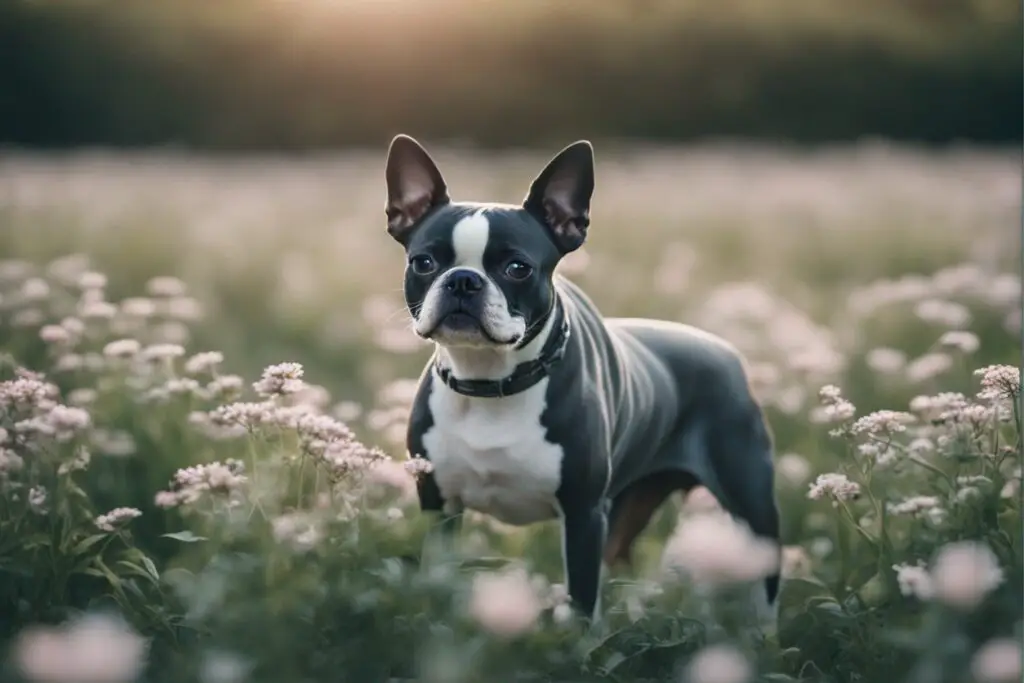
Temperament
Blue Boston Terriers are known for:
- Their friendly nature
- Being great with kids
- Having an energetic personality
They love being part of family activities and get along well with other pets!
The tuxedo pattern on some Blue Boston Terriers makes them look like they are dressed up for a party! And speaking of coats…
Coat Types and Colors
ThereThere’s variation when it comes to coat types among Blue Boston Terriers:
- Some have a smooth coat, while others have a more coarse texture.
- Coat colors can range from deep blue-gray to lighter shades.
Despite not having the standard black nose or skin associated with most terriers, these dogs are as lovable and endearing as any other breed!
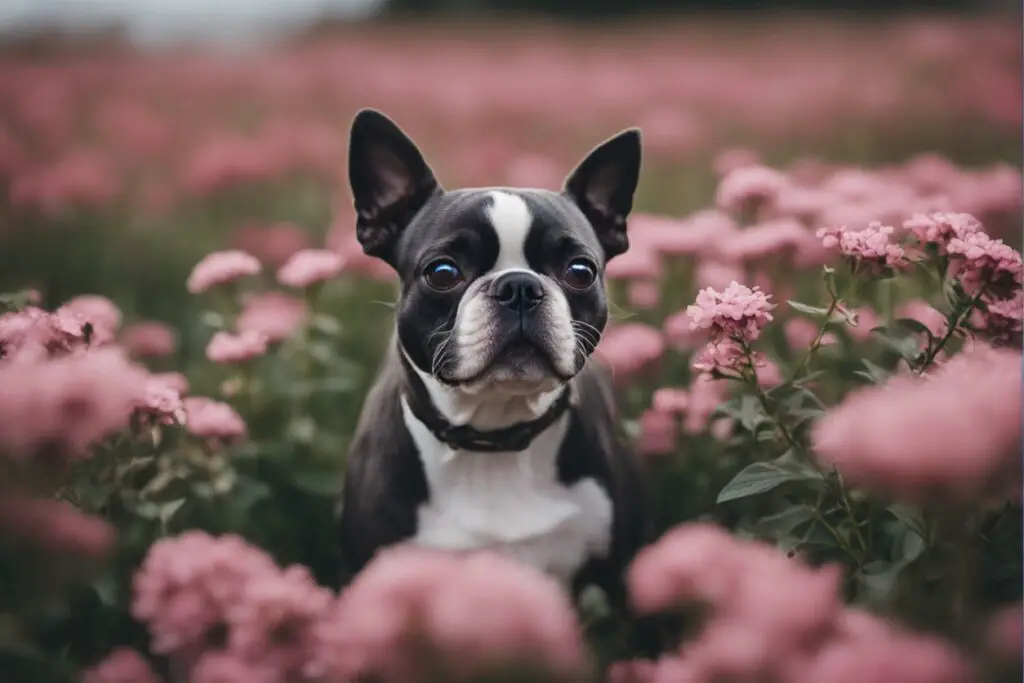
Origin and History of Blue Boston Terriers
Blue Boston Terriers are like the cool kids in the dog world. They are not your average Boston Terrier, and they are something special. Why? It’s about genetics, my friend.
The Genetic Factor
These unique pups result from a specific genetic mutation in traditional Boston Terriers. No mad science here, just Mother Nature is doing her thing. This mutation isn’t a freak occurrence, though, it’s rare and makes these dogs extra unique.
- Traditional Boston Terrier: Fawn or brindle coat
- Blue Boston Terrier: Blue or blue-grey coat
Breed Standards and Recognition
The upcoming section delves into the fascinating world of breed standards and recognition. We’ll explore the specific criteria that define different breeds, the breed recognition process, and the organizations that set these standards. This comprehensive guide will provide valuable insights for breed enthusiasts and pet owners. So, let’s look at what makes each breed unique and how they gain official recognition.
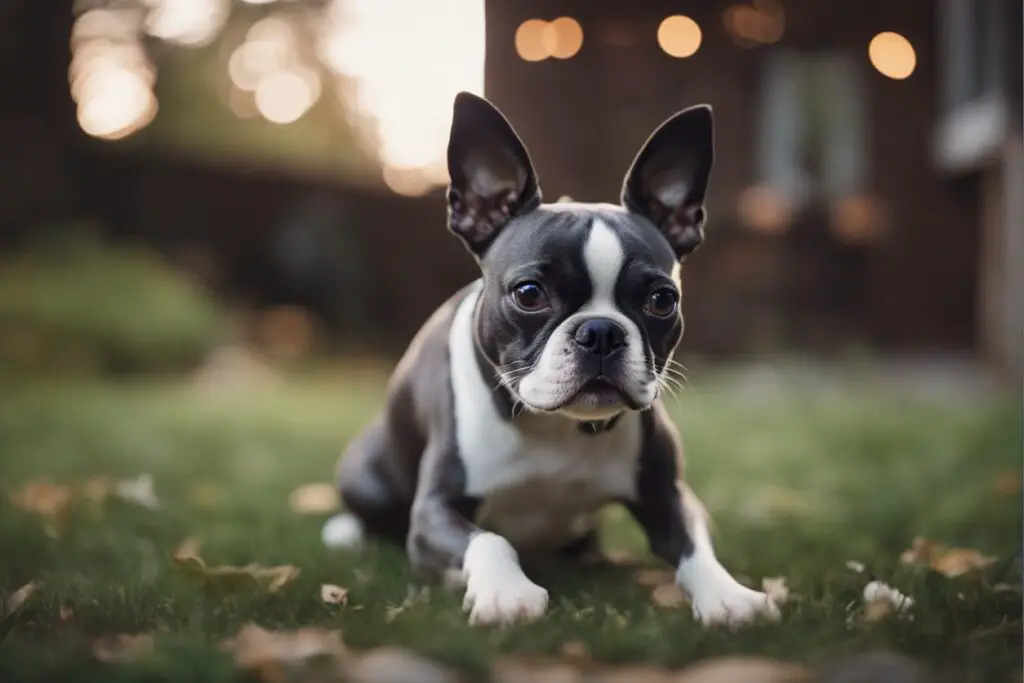
Demand for Uniqueness
Their unique appearance has sparked an increased demand among dog lovers everywhere. Who wouldn’t want a pup with such a standout color? It owns a limited edition piece of art!
So there you have it – the lowdown on Blue Boston Terriers. From their genetic mutation to their rise in popularity, these dogs sure do have an exciting history!
Understanding Health Concerns in Blue Boston Terriers
Blue Boston Terriers, though incredibly cute, can face specific health issues. Their unique color comes from pigment dilution, which unfortunately makes them prone to skin conditions.
Skin Conditions and Risks
- Hair loss
- Dry skin
- Inflammation
These are some of the skin-related health issues they may encounter. Regular vet check-ups are crucial to manage these risks effectively.
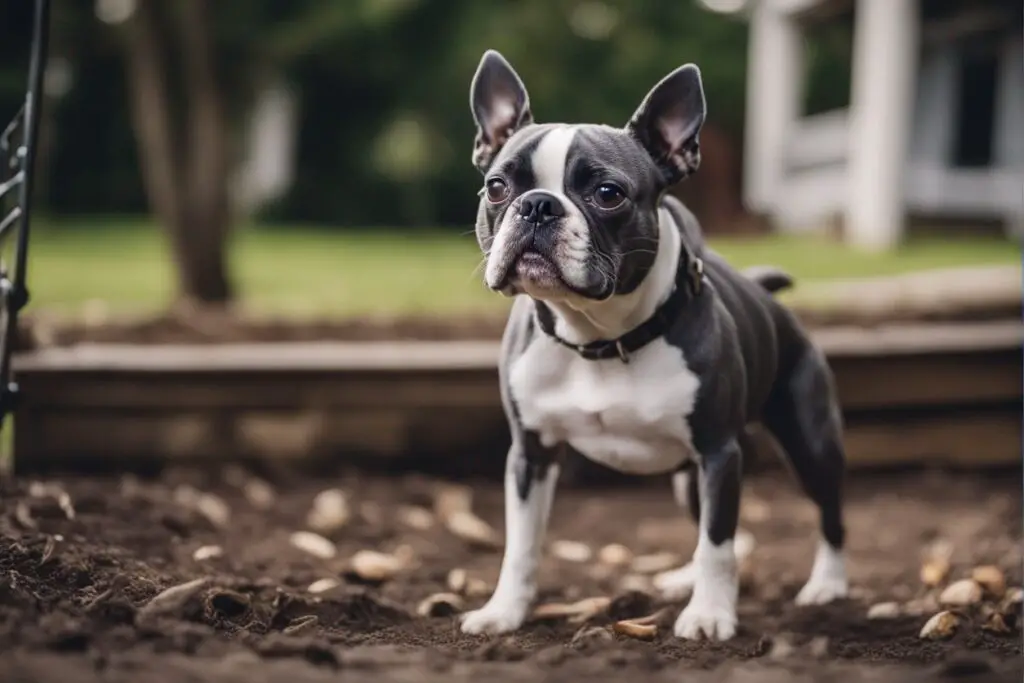
Deafness Risk
Unlike other colors, blue Boston terriers have a higher chance of being born deaf or becoming deaf early in life. Regular hearing checks can help detect any problems early on.
Eye issues are another concern for these adorable pups. They have a potential for developing cataracts or corneal ulcers due to their genetic makeup.
Eye Issues
- Cataracts
- Corneal ulcers
Regular eye exams can help catch these conditions early and provide the best care possible for your furry friend.
Caring for a Blue Boston Terrier: Lifestyle Needs
Regular Exercise
Don’t let their size fool you! Blue Boston Terriers, like all pets, need regular exercise. They may be tiny, but their love for activity is enormous. Daily walks and some playtime at home will keep them happy and healthy.
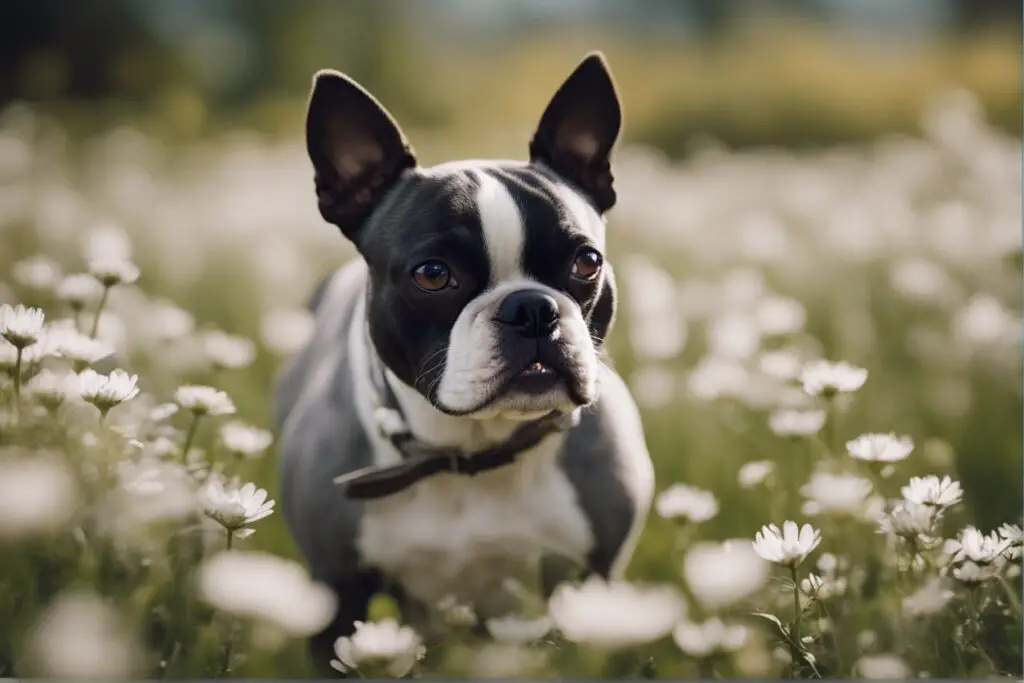
Mental Stimulation
Just as important as physical activity is mental stimulation. These dogs are known for their affectionate nature and intelligence:
- Training sessions teach them new tricks and keep their minds sharp.
- Interactive toys can provide hours of mental engagement.
Remember to mix it up to keep things interesting!
Sensitivity to Temperatures
Blue Boston Terriers are sensitive to extreme temperatures due to their thin coats. Special care is needed:
- In hot weather, ensure they have plenty of shade and water.
- During winter months, consider doggy sweaters or indoor activities.
Their comfort should always be a priority.

Food and Families
These pups aren’t big eaters but providing balanced meals will meet their nutritional needs. Their small size makes them great for families with limited space. But remember, despite being small in size, they are big in love!
Dietary Requirements for Blue Boston Terriers
Chow Time Essentials
Blue Boston Terriers need a diet rich in high-quality proteins and fats. Here’s what to look out for:
- Protein: Chicken, beef, or fish are excellent sources.
- Fats: Omega-3 and Omega-6 fatty acids are found in fish oil or flaxseed.
Their specific dietary needs stem from potential health issues common to the breed. For instance, they can suffer from food allergies. So, it’s important to identify and avoid specific allergens:
- Grains like wheat and corn
- Dairy products
- Artificial additives
Dry food is often a safe bet for their diet as it’s too digest and less likely to contain allergens.
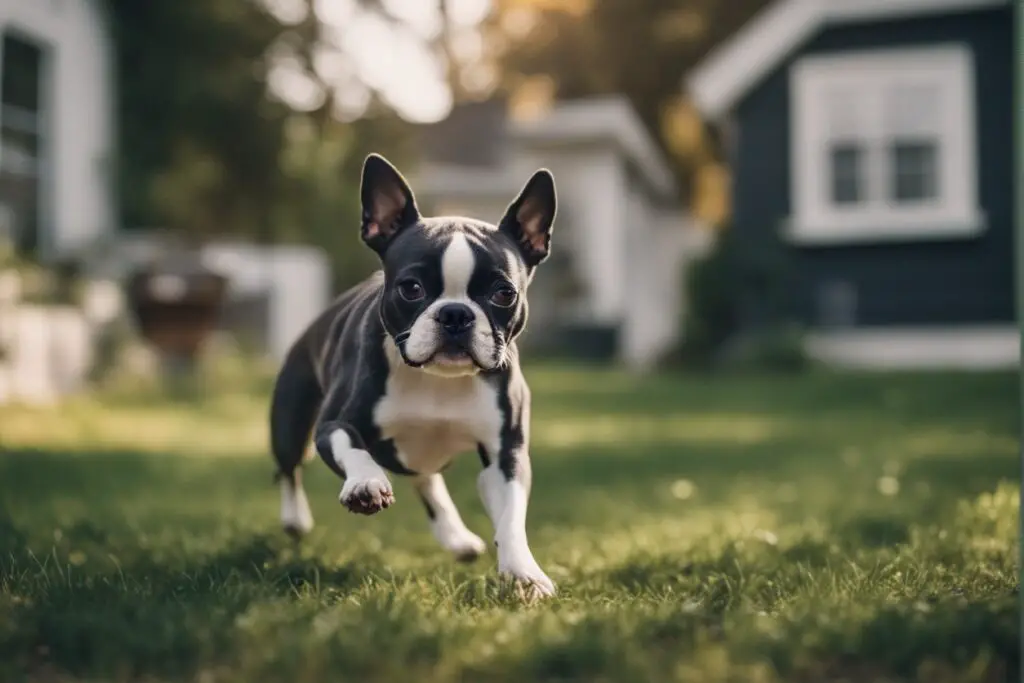
Remember though, every Blue Boston Terrier is unique! What works for one might not work for another. It’s It’sys best to consult with your vet before making any significant changes to your diet.
And who said humans are the only ones who deserve a balanced diet? Your furry friend does too!
AKC Stance on Blue Boston Terriers
Let’s cut to the chase. The American Kennel Club (AKC), a big name in dog breeds, doesn’t recognize blue Boston terriers. Why? Simply put, they deviate from breed standards.
Breed Standards and Registration
Breed standards are like a rule book for each dog breed. For Boston terriers, standard colors include brindle, black, or seal with white markings. So, where does this leave our blue buddies?
- No-show eligibility: Blue Bostons can’t strut their stuff in AKC shows because of their non-standard color.
- Pedigree registration issues: Registering a blue Boston as purebred? That’s a no-go with the AKC.
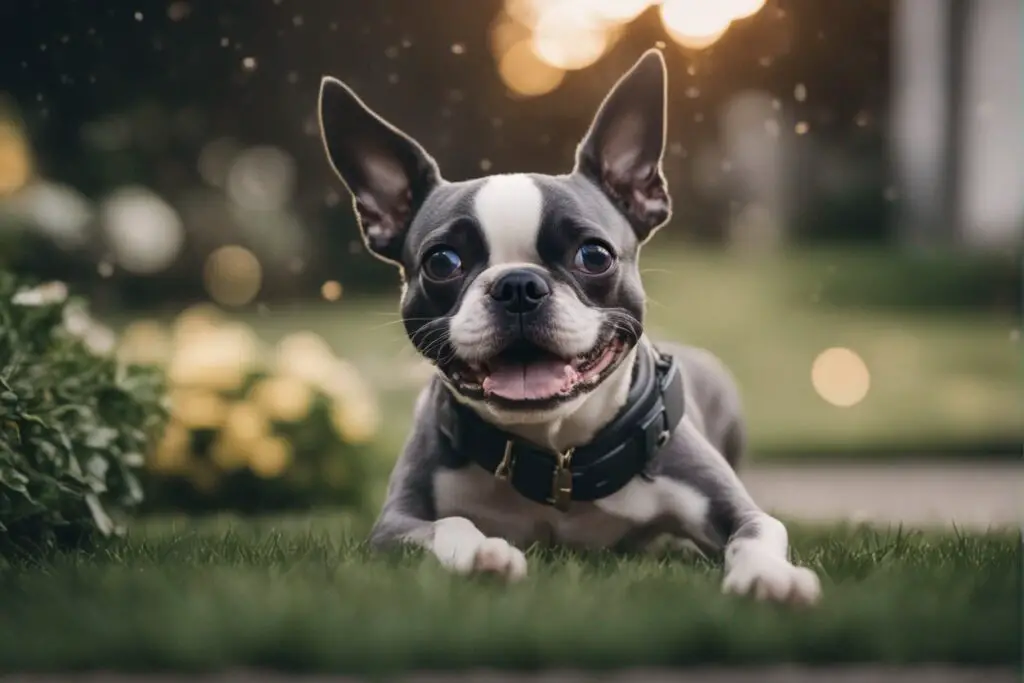
Ongoing Debates within Breeding Communities
It isn’t all doom and gloom for blue Bostons, though. Many breeding communities are arguing about whether these unique pooches should be accepted.
- Some folks reckon breed standards need an update to include blues.
- Others think sticking to traditional rules is the way forward.
The debate rages on! But one thing is sure – whether color, brindle or blue – every Boston terrier deserves love and respect.
Wrapping Up the Blue Boston Terrier Saga
Well, there you have it! We’ve been through the ins and outs of what makes a blue Boston terrier tick. From their unique coat color to their dietary needs and even a bit about what the AKC thinks about them. Now, you are pretty much an expert on these little blue dynamos. But remember, owning any pet is a big responsibility, so make sure you for all that comes with having one of these fellas in your life.
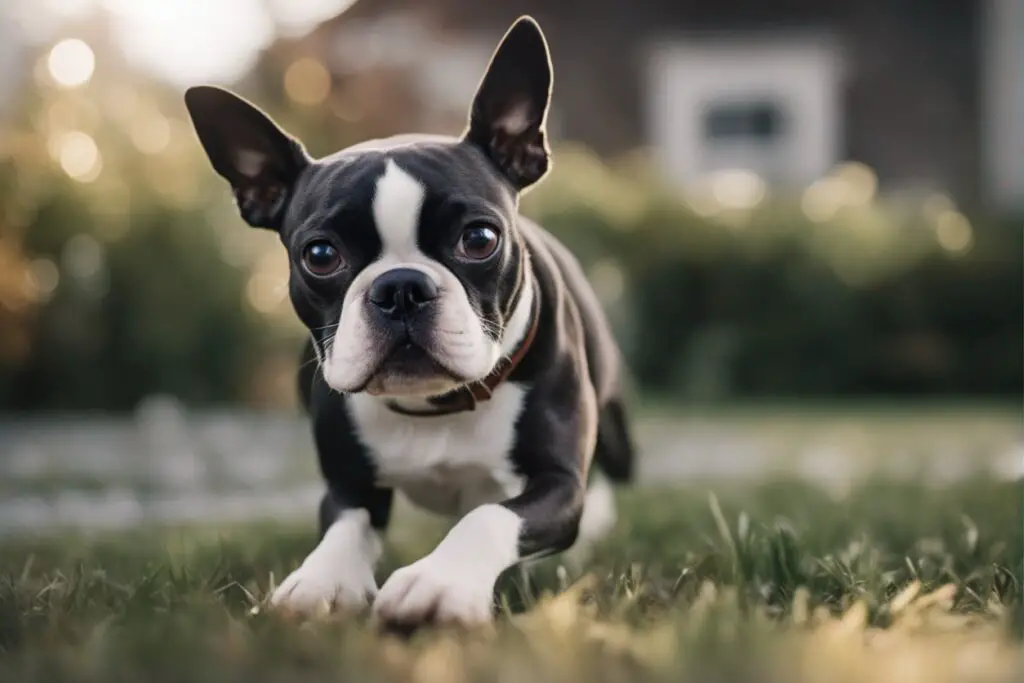
Ready to bring home your very own blue Boston terrier? Do your homework first – consider their health issues and lifestyle needs. And don’t forget to check out reputable breeders or adoption centers. After all, every pup deserves a loving home, right? So go ahead – plunge into the world of blue Boston terriers!
FAQs
What are some common health problems in Blue Boston Terriers?
Blue Boston Terriers can be prone to specific health issues like skin disorders and deafness due to their unique coloring. It’s It’srtant to get regular vet check-ups for early detection and treatment.
Can Blue Boston Terriers compete in dog shows?
The American Kennel Club (AKC) doesn’t recognize color variation for competition standards. However, they can still participate in events like agility or obedience trials.
What kind of diet does a Blue Boston Terrier need?
These dogs do well on high-quality commercial dog food formulated for small breeds. Some may also benefit from a grain-free diet if they have allergies.
How active are Blue Boston Terriers?
They are energetic little pups who love playtime but are happily chilling at home with their humans. Regular exercise is essential to keep them fit and healthy.
Where can I get a Blue Boston Terrier?
You can find them through reputable breeders or adoption centers, but always thoroughly research before bringing one home.